Related Research Articles

28978 Ixion (, provisional designation 2001 KX76) is a large trans-Neptunian object and a possible dwarf planet. It is located in the Kuiper belt, a region of icy objects orbiting beyond Neptune in the outer Solar System. Ixion is classified as a plutino, a dynamical class of objects in a 2:3 orbital resonance with Neptune. It was discovered in May 2001 by astronomers of the Deep Ecliptic Survey at the Cerro Tololo Inter-American Observatory, and was announced in July 2001. The object is named after the Greek mythological figure Ixion, who was a king of the Lapiths.
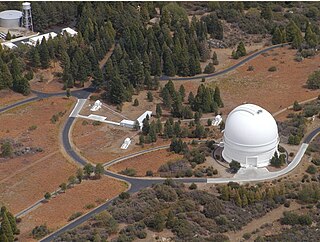
Palomar Observatory is an astronomical research observatory in the Palomar Mountains of San Diego County, California, United States. It is owned and operated by the California Institute of Technology (Caltech). Research time at the observatory is granted to Caltech and its research partners, which include the Jet Propulsion Laboratory (JPL), Yale University, and the National Astronomical Observatories of China.

Stardome Observatory & Planetarium is a public astronomical observatory and planetarium situated in Maungakiekie/One Tree Hill Domain in Auckland, New Zealand.

A grazing lunar occultation is a lunar occultation in which as the occulted star disappears and reappears intermittently on the edge of the Moon. A team of many observers can combine grazes and reconstruct an accurate profile of the limb lunar terrain.
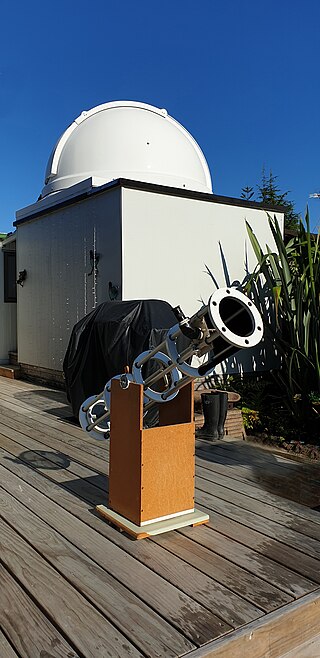
Farm Cove Observatory (FCO) was an amateur astronomical observatory in Pakuranga, Auckland, New Zealand, where Jennie McCormick discovered the main-belt asteroid 386622 New Zealand in September 2009.
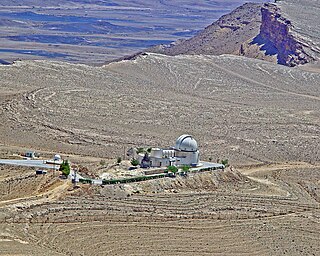
The Florence and George Wise Observatory is an astronomical observatory owned and operated by Tel Aviv University. It is located 5 kilometers west of the town of Mitzpe Ramon in the Negev desert near the edge of the Ramon Crater, and it is the only professional astronomical observatory in Israel.

The Kodaikanal Solar Observatory is a solar observatory owned and operated by the Indian Institute of Astrophysics. It is on the southern tip of the Palani Hills 4 kilometres (2.5 mi) from Kodaikanal.
Leuschner Observatory, originally called the Students' Observatory, is an observatory jointly operated by the University of California, Berkeley and San Francisco State University. The observatory was built in 1886 on the Berkeley campus. For many years, it was directed by Armin Otto Leuschner, for whom the observatory was renamed in 1951. In 1965, it was relocated to its present home in Lafayette, California, approximately 10 miles (16 km) east of the Berkeley campus. In 2012, the physics and astronomy department of San Francisco State University became a partner.
The Amateur Astronomers Association of Pittsburgh (AAAP) is an Astronomical Organization founded on June 9, 1929, by Chester B. Roe and Leo J. Scanlon. Since its establishment, it has grown to have over 500 members and operates two observatories in the Pittsburgh region: the Nicholas E. Wagman Observatory and the Mingo Creek Park Observatory. The club also sponsors many star parties that are open to the public throughout the year.
Anderson Mesa Station is an astronomical observatory established in 1959 as a dark-sky observing site for Lowell Observatory. It is located at Anderson Mesa in Coconino County, Arizona, about 12 miles (19 km) southeast of Lowell's main campus on Mars Hill in Flagstaff, Arizona.

Ian Paul Griffin is a New Zealand astronomer, discoverer of minor planets and a public spokesman upon scientific matters. He is currently the Director of Otago Museum, Dunedin, New Zealand. Griffin was the CEO of Science Oxford, in Oxford, United Kingdom, and the former head of public outreach at NASA's Space Telescope Science Institute.
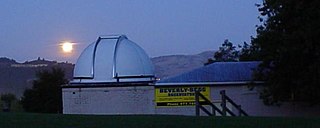
The Beverly-Begg Observatory is a New Zealand astronomical observatory, situated in Robin Hood Park in the Belleknowes part of Dunedin's town belt. It was established in 1922 by the Dunedin Astronomical Society (DAS) and is the home of the group.

The Hirsch Observatory is an astronomical observatory at Rensselaer Polytechnic Institute (RPI) in Troy, New York. It is located on the roof of the Jonsson-Rowland Science Center and is used by members of the Rensselaer Astrophysical Society as well as astronomy students in laboratory exercises. It is frequently opened to the community for public viewing sessions. The observatory's main dome contains a 16" Cassegrain Reflector, with a CCD camera and fully computerized controls. The observatory also owns a variety of smaller scopes and a SBIG Spectrograph. The spectrograph has been used to catalog bright solar spectrum as part of an effort to create an online digital database for astrophysical research. The current director of the observatory is Professor Heidi Newberg.

The Dearborn Observatory is an astronomical observatory located on the Evanston campus of Northwestern University. The observatory was originally constructed in 1888, through an agreement between the university and the Chicago Astronomical Society. In the summer of 1939, Dearborn Observatory had to be moved to make way for the construction of the Technological Institute.
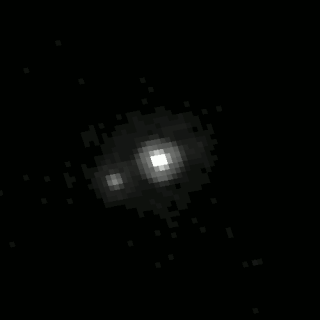
Vanth is a natural satellite or moon of the large trans-Neptunian dwarf planet Orcus. It was discovered by Michael Brown and Terry-Ann Suer using images taken by the Hubble Space Telescope on 13 November 2005. The moon has a diameter of 443 km (275 mi), making it about half the size of Orcus and the third-largest moon of a trans-Neptunian object. Vanth is massive enough that it shifts the barycenter of the Orcus–Vanth system outside of Orcus, forming a binary system in which the two bodies revolve around the barycenter, much like the Pluto–Charon system. It is hypothesized that both systems formed similarly, most likely by a giant impact early in the Solar System's history. Compared to Orcus, Vanth has a darker and slightly redder surface that supposedly lacks exposed water ice, resembling primordial Kuiper belt objects.
The Royal Astronomical Society of New Zealand (RASNZ) is the New Zealand national astronomical society. It is an association of professional and amateur astronomers with the prime objective to the promotion and extension of knowledge of astronomy and related branches of science.

The Mount Stony Brook Observatory is an astronomical observatory operated by Stony Brook University in Stony Brook, New York. It is located on the roof of the Earth and Space Sciences Building. The dome contains a Meade 14" Maksutov–Cassegrain telescope and SBIG (SBIG-STL1001e) imaging equipment. The telescope is used for teaching undergraduate and graduate astronomy labs by the department, as well as by the Astronomy club. The observatory's imaging capabilities have been used to monitor variable stars. On the first Friday of every month during the school year the department hosts "Astronomy Open Nights" during which a lecture is given, followed by observing if the weather permits. The observatory was built in 1968 and Astronomy Open Nights have been held there since 1976. The current telescope was installed in 1981.

Arthur Beverly was a New Zealand watchmaker, mathematician and astronomer.
Tenagra Observatory and Tenagra Observatory II are astronomical observatories in Cottage Grove, Oregon and Arizona. The observatories house heavily automated robotic telescopes.
Amanda Bosh is an American planetary scientist and observational astronomer best known for her work on small solar system objects. She is the chief operating officer at Lowell Observatory in Flagstaff, Arizona. and is involved which the Lowell Observatory Native American Outreach program, which she co-founded.
References
- ↑ "RASNZ Affiliated Societies - DAS". Archived from the original on 1 February 2010. Retrieved 25 May 2009.
- ↑ Royal Society of New Zealand, Otago Branch - Historical Review
- ↑ Transactions and Proceedings of the Royal Society of New Zealand - Volume 45
- ↑ Transactions and Proceedings of the Royal Society of New Zealand - Volume 79
- ↑ Link Charity Summary page
- ↑ Otago Institute - DAS Centennial Program Archived 24 July 2011 at the Wayback Machine
- ↑ "IOTA-VTI" . Retrieved 14 August 2016.
- ↑ "The ST-8300M and ST-8300C High Resolution CCD Cameras". SBIG. Retrieved 14 August 2016.
- ↑ Gibb, John (June 2015). "Fleeting moment in Pluto's shadow". Otago Daily Times. Retrieved 14 August 2016.
- ↑ Sicardy, B.; Talbot, J.; Meza, E.; Camargo, J. I. B.; Desmars, J.; Gault, D.; Herald, D.; Kerr, S.; Pavlov, H.; Braga-Ribas, F.; Assafin, M.; Benedetti-Rossi, G.; Dias-Oliveira, A.; Ramos-Gomes-Jr, A.; Vieira-Martins, R.; Berard, D.; Kervella, P.; Lecacheux, J.; Lellouch, E.; Beisker, W.; Dunham, D.; Jelinek, M.; Duffard, R.; Ortiz, J. L.; Castro-Tirado, A. J.; Cunniffe, R.; Querel, R.; Yock, P. A.; Cole, A. A.; et al. (2016). "Pluto's atmosphere from the 29 June 2015 ground-based stellar occultation at the time of the New Horizons flyby". The Astrophysical Journal Letters. 819 (2). arXiv: 1601.05672 . doi: 10.3847/2041-8205/819/2/L38 .